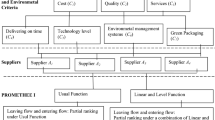Abstract
We apply the Perron theorem in multi-attribute decision making. We create a comparison matrix for decision alternatives and prove that the matrix is almost-always primitive. We use the limiting power of the matrix multiplied by a standard vector, which leads to a positive eigenvector of the matrix, as the ranking vector for decision alternatives. The proposed method does not require domain experts to assign weights for decision criteria as usually demanded by the weighted-sum model. The new method is simple to use and generates reasonable result as illustrated by an example of ranking best hospitals over twelve criteria. We also demonstrate that the weightedsum methods may not be able to reveal all possible rankings. We give one example showing that a weighted-sum method collapsed thirteen distinct rankings into a single ranking and another example showing that the weighted-sum methods could not produce the ranking that is unrenderable by linear functions.
Similar content being viewed by others
Notes
For each specialty, only the top 50 hospitals were published. Thus, “\({>}\)50” is assigned to the hospitals that were not ranked in the top 50 so that they can be evaluated against the ones among top 50. However, when there are multiple “\({>}\)50” hospitals on a given specialty, any two of them are treated as incomparable.
The diagonal of the comparison matrix represents that a hospital is evaluated against itself. Thus, the diagonal retains a value of 0.5, i.e., the hospital ties with itself; performing neither better nor worse than itself.
We are grateful to the referee’s insightful suggestion.
References
Austin, D. (2008). How Google finds your needle in the web’s haystack. AMS Feature Column. http://www.ams.org/samplings/feature-column/fcarc-pagerank. Accessed 28 April 2016.
Berman, A., & Plemmons, R. (1979). Nonnegative matrices in the mathematical sciences. Cambridge: Academic Press.
Brans, J., Mareschal, B., & Vincke, P. (1984). PROMETHEE: A new family of outranking methods in multicriteria analysis. In J. Brans (Ed.), Operational research (pp. 477–490). Amsterdam: IFORS 84.
Figueira, J., Greco, S., & Ehrgott, M. (Eds.). (2005). Multiple criteria decision analysis: State of the art surveys. New York: Springer.
Hwang, C., & Yoon, K. (1981). Multiple attribute decision making: Methods and applications; A state-of the-art survey. New York: Springer.
Keener, J. P. (1993). The Perron-Frobenius theorem and the ranking of football teams. SIAM Review, 35(1), 80–93.
Keeney, R., & Raiffa, H. (1976). Decisions with multiple objectives: Preferences and value tradeoffs. New York: Wiley.
Köksalan, M., Wallenius, J., & Zionts, S. (2011). Multiple criteria decision making: From early history to the 21st century. Singapore: World Scientific.
Langville, A. N., & Meyer, C. (2012). Google’s PageRank and beyond: The science of search engine rankings. Princeton: Princeton University Press.
McGinley, P. (2014). Decision analysis software survey. OR/MS Today.
Olmsted, M., Geisen, E., Murphy, J., Bell, D., Morley, M. & Stanley, M. (2014). Methodology: U.S. news & world report: Best hospitals 2014–15. http://www.usnews.com/pubfiles/BH_2014_Methodology_Report_Final_Jul14.pdf. Accessed 28 January 2015.
Opricovic, S., & Tzeng, G.-H. (2004). The compromise solution by MCDM methods: A comparative analysis of VIKOR and TOPSIS. European Journal of Operational Research, 156(2), 445–455.
Ozdemir, M. S. (2005). Validity and inconsistency in the analytic hierarchy process. Applied Mathematics and Computation, 161(3), 707–720.
Pereira, V. & Costa, H. G. (2014). Nonlinear programming applied to the reduction of inconsistency in the AHP method. Annals of Operations Research. doi:10.1007/s10479-014-1750-z.
Rezaei, J. (2015). Best-worst multi-criteria decision-making method. Omega, 53, 49–57.
Roy, B. (1968). Classement et choix en presence de points de vue multiples (la méthode ELECTRE). RIRO, 8, 57–75.
Roy, B. (1991). The outranking approach and the foundations of ELECTRE methods. Theory and Decision, 31(1), 49–73.
Saaty, T. L. (1977). A scaling method for priorities in hierarchical structures. Journal of Mathematical Psychology, 15(3), 234–281.
Saaty, T. L. (1990). How to make a decision: The analytic hierarchy process. European Journal of Operational Research, 48, 9–26.
Saaty, T. L. (1996). Decision making with dependence and feedback: The analytic network process. Pittsburgh, Pennsylvania: RWS Publications.
Triantaphyllou, E. (2000). Multi-criteria decision making methods: A comparative study. US: Springer.
van Valkenhoef, G., Tervonen, T., Zwinkels, T., de Brock, B., & Hillege, H. (2013). ADDIS: A decision support system for evidence-based medicine. Decision Support Systems, 55(2), 459–475.
Xu, X. (2001). The SIR method: A superiority and inferiority ranking method for multiple criteria decision making. European Journal of Operational Research, 131(3), 587–602.
Zopounidis, C., & Doumpos, M. (2000). PREFDIS: A multicriteria decision support system for sorting decision problems. Computers & Operations Research, 27(7–8), 779–797.
Author information
Authors and Affiliations
Corresponding author
Rights and permissions
About this article
Cite this article
Huang, P.H., Moh, Tt. A non-linear non-weight method for multi-criteria decision making. Ann Oper Res 248, 239–251 (2017). https://doi.org/10.1007/s10479-016-2208-2
Published:
Issue Date:
DOI: https://doi.org/10.1007/s10479-016-2208-2




